PAGE 54 – OCTOBER 2006
H O T I D E A S F O R S M A L L R A I L R O A D S

And still they come … shelf layouts with eye appeal and operating appeal.
Here are a bunch more that we’ve received from readers of this page. There
are a ton of good ideas here, waiting for you to pick them up and use them!
The layout above is Rayner’s Yard, being built by Jack Trollope (see story below).
M O R E L A Y O U T S W I T H T R A V E R S E R S
Traversers (transfer tables) are an easy and useful way to move cars, locomotives or even entire trains from track to track behind the scenes. Because such tables were used in the prototype, they can also be left in plain sight. Here are several examples of traversers used to enliven shelf layouts and significantly enhance their operations.
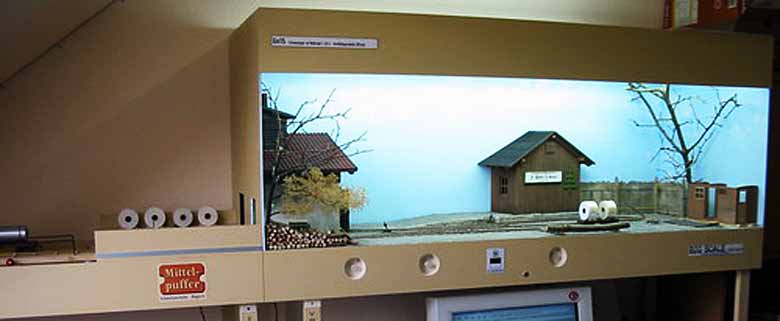
This appealing Gn15 shelf layout is being built by Alexander Lösch, from Elfershausen in Bavaria, Germany. This little shelf line measures 130x45cm (51x18in) and uses 1:22.5 scale trains (same as LGB) running on 16.5mm tracks to represent a prototype 15-inch (380mm) narrow-gauge railway. Alexander uses several creative techniques, including a small turntable made from a PVC pipe end-cap swiveling in a section of pipe. His traverser fiddle yard, which helps provide a steady flow of traffic to the visible part of the layout, also has storage tracks for locomotives and rolling stock. We’ll try to keep you posted on Alexander’s progress in building this attractive little line, but you can find more information right away on his website.
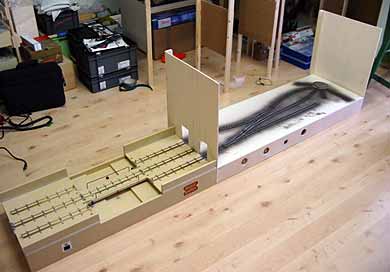
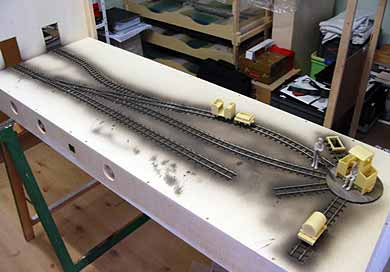
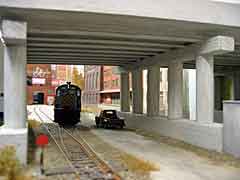
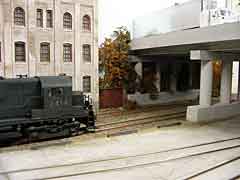
 Also working in Gn15 scale is Brian Rudko, Vancouver, Canada. This 4x2ft work-in-progress layout represents Pender Iron & Steel, a works where ingots are melted down into structural shapes. The photo shows an early mockup using paper track to determine positions of trackage and buildings.
Also working in Gn15 scale is Brian Rudko, Vancouver, Canada. This 4x2ft work-in-progress layout represents Pender Iron & Steel, a works where ingots are melted down into structural shapes. The photo shows an early mockup using paper track to determine positions of trackage and buildings.
Brian explains, “At the back (hidden by that rear building) are two staging tracks that feed to a transfer table (traverser) in the brick building to the right. Then there will be a spur
track and a cross track that crosses to a sector plate in the building to the left, that ultimately feeds the track at the very front where the only track switch on the layout is located.”
The gantry crane (center rear) is fed by a stub-end spur track accessed by the transfer table (visible at the right rear). The table is still under construction and is mostly acrylic. We’ll keep you posted on progress of this attractive little line!

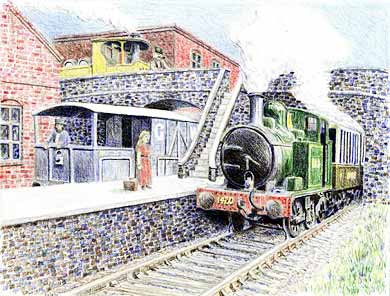 Jeff Hartmann is an American living in Long Beach, California, USA. However, he has designed a classic British railway station micro layout. It’s a through station called Westchester (also the name of another Los Angeles suburb), and it uses a pair of concealed transfer tables (traversers), one at each end of the main 24x8in (60x20cm) module, to feed a stream of trains to the “onstage” station layout.
Jeff Hartmann is an American living in Long Beach, California, USA. However, he has designed a classic British railway station micro layout. It’s a through station called Westchester (also the name of another Los Angeles suburb), and it uses a pair of concealed transfer tables (traversers), one at each end of the main 24x8in (60x20cm) module, to feed a stream of trains to the “onstage” station layout.
Jeff describes the operation this way: “Passenger service would be provided by auto trains (short push-pull trains powered by steam tank locomotives). The freight would be handled by small tank engines or 08 class diesels. The layout has a double track main line and two factory spurs. The two traversers are used as a staging area for the trains and also to allow the engines to run around their trains when switching the factory spurs.”
Jeff also made the drawing of the station that appears here. For more about his modeling efforts, check out his website.
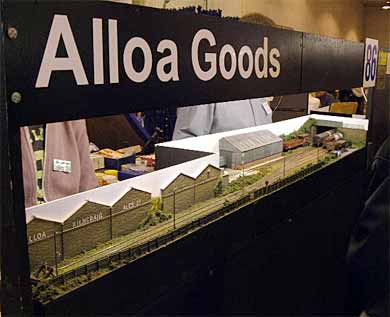
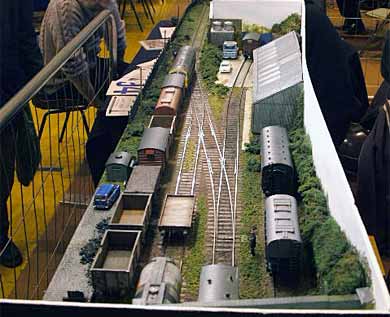
Alloa Goods was built by Jeff Taylor, from Hull, England, for a competition that limited size to 654 square inches (about 4.5 square feet). Jeff’s entry, which is nearly 8ft (2.4m) long, comes in at 650 square inches! Based on a harbour branch that existed in Alloa, Scotland, the layout is built in EM scale (4mm to the foot (1:76) running on 18.2mm gauge). A simple traverser (transfer table shown below, right) is used to supply trains to the visible part of the layout.According to Jeff, “The plan takes the form of a classic Inglenook with an additional siding. The maximum train length is one loco and 5 wagons. These are either pulled or shunted in. There isn’t a run round facility, so wagons are shunted by ‘chain shunting’.” A 10-inch chain with 10 links to the inch is attached to the rolling stock using the scale hooks on the prototypical three-link couplers. To couple and uncouple, Jeff uses a pen torch (flashlight) with a length of brass that has a hook on the end (shown below, left). A steady hand is required!
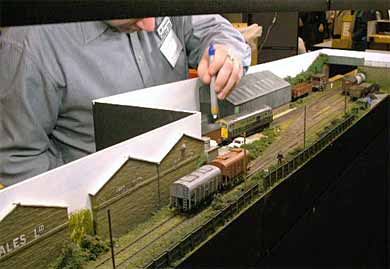
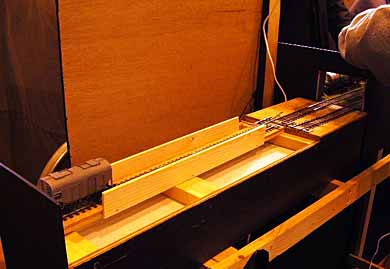
TIME TO GET MOVING ON HOLIDAY DISPLAYS!
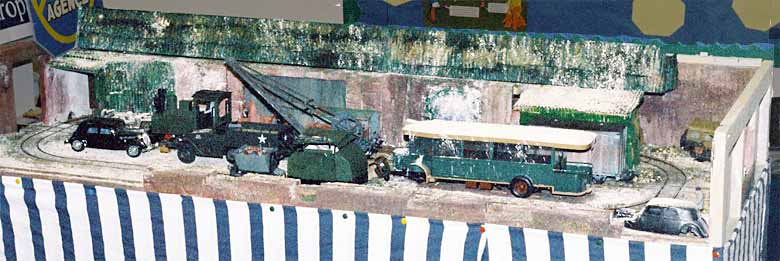
A REALLY SMALL TRANSPORTABLE SHELF LAYOUT
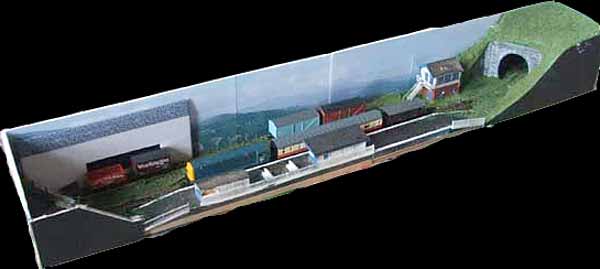 Ysgethin is a portable N-scale branchline layout built “on the cheap” by an “impoverished student,” Ben Bucki from Carlisle, England. Each module of the foldup design is 35x10cm (14x4in), and the whole is concocted from Ben’s existing N stock and castoffs from the local DIY store.
Ysgethin is a portable N-scale branchline layout built “on the cheap” by an “impoverished student,” Ben Bucki from Carlisle, England. Each module of the foldup design is 35x10cm (14x4in), and the whole is concocted from Ben’s existing N stock and castoffs from the local DIY store.
Despite the layout’s small dimensions, Ben points out that, “When assembled it gives a run of about 105cm including the fiddle yard, and the loop is just long enough for a small loco, carriage, and maybe one or two goods wagons… The fiction behind the layout is that it is a small intermediate halt on a mothballed freight line in north/mid Wales that has been acquired by a preservation group and it is in its first operating season–hence the short trains, general dilapitation of buildings, and the overgrown track.” Photos below show how the layout “folds and packs.”
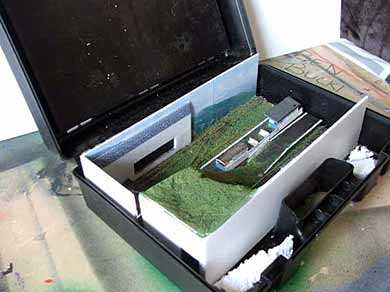
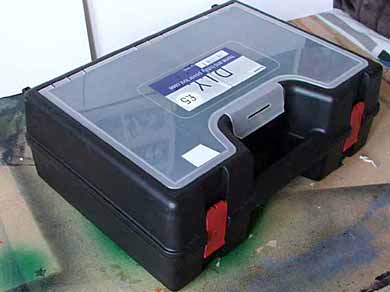
A VISIBLE REVERSING TURNTABLE!
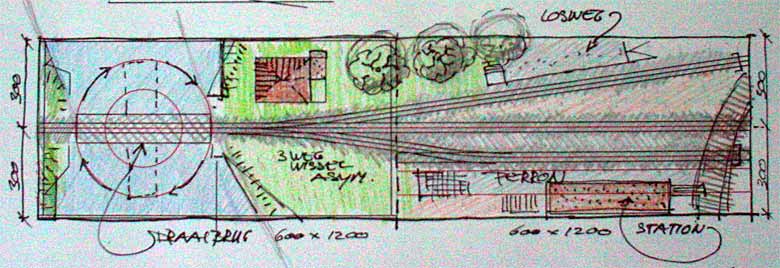
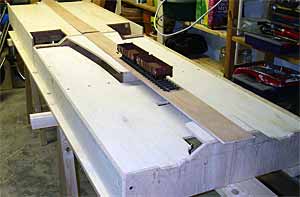 This “shelf” is 8ft long and 2ft wide (2400x600mm)! But of course, it’s O scale (1:45). This is Draaibrug (Swing Bridge) by Ernst-Peter Everaardt from Halfweg, The Netherlands. The layout is being built in two modules, each 1200x600mm (4x2ft). A three-way asymmetrical lap turnout provides three sidings for an Inglenook style switching game. But the highlight of the layout (now under construction, as shown at right) is the Dutch-style swing bridge, or draaibrug. Ernst-Peter’s bridge, rather than rotating just 90 degrees to allow tall shipping to pass, actually will rotate 180 degrees–reversing any rolling stock that occupies it at the time! The result: a “hidden” turntable that happens to be in plain sight! We’ll try to keep you posted as construction proceeds.
This “shelf” is 8ft long and 2ft wide (2400x600mm)! But of course, it’s O scale (1:45). This is Draaibrug (Swing Bridge) by Ernst-Peter Everaardt from Halfweg, The Netherlands. The layout is being built in two modules, each 1200x600mm (4x2ft). A three-way asymmetrical lap turnout provides three sidings for an Inglenook style switching game. But the highlight of the layout (now under construction, as shown at right) is the Dutch-style swing bridge, or draaibrug. Ernst-Peter’s bridge, rather than rotating just 90 degrees to allow tall shipping to pass, actually will rotate 180 degrees–reversing any rolling stock that occupies it at the time! The result: a “hidden” turntable that happens to be in plain sight! We’ll try to keep you posted as construction proceeds.
As Jack Trollope’s small shelf layout, Box Street Yard, approaches the status of a classic design, we’re seeing more and more variations of it. In fact, that’s one definition of a classic–“an often adopted basis for others’ layouts”! Here are some examples, including a couple from the irrepressible “Shortliner” Jack himself in his lair way up in the Scottish Highlands.

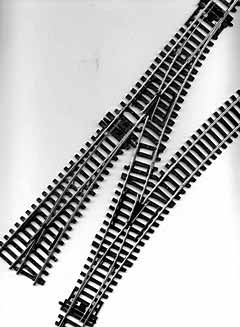 The original Box Street Yard makes good use of a double slip switch, sometimes known as a “puzzle switch”. In this case, Jack Trollope reached back to a design by Malcolm Carlsson featured in Scale Model Trains magazine almost 20 years ago — a space-saving O scale yard in just a 48in shelf length! Malcolm’s trick was to use a hand-laid three-way turnout to shorten the yard ladder … and Jack adapted the idea by using commercial Peco turnouts to make a “poor man’s three way switch.” He “hacked and reassembled” Peco Small Radius Streamline and Setrack left-hand turnouts to make the formation shown at right.Then a friend, who was looking for a small-space layout design in OO/HO, asked if there were a way to combine this ingenious triplex with a runaround capability … and voilà! Jack came up with the Box Street variation shown above. This HO design uses 50ft U.S. style freight cars, and it could be even shorter using the older 40ft cars.
The original Box Street Yard makes good use of a double slip switch, sometimes known as a “puzzle switch”. In this case, Jack Trollope reached back to a design by Malcolm Carlsson featured in Scale Model Trains magazine almost 20 years ago — a space-saving O scale yard in just a 48in shelf length! Malcolm’s trick was to use a hand-laid three-way turnout to shorten the yard ladder … and Jack adapted the idea by using commercial Peco turnouts to make a “poor man’s three way switch.” He “hacked and reassembled” Peco Small Radius Streamline and Setrack left-hand turnouts to make the formation shown at right.Then a friend, who was looking for a small-space layout design in OO/HO, asked if there were a way to combine this ingenious triplex with a runaround capability … and voilà! Jack came up with the Box Street variation shown above. This HO design uses 50ft U.S. style freight cars, and it could be even shorter using the older 40ft cars.
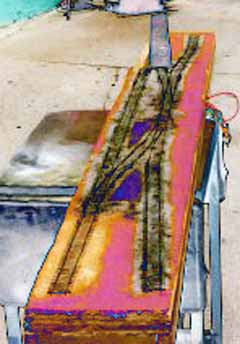
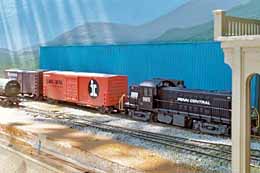
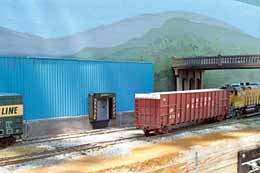
Meanwhile, far away in Los Angeles, USA, John Bruce was working on a similar Box Street variation, shown in an artistic rendition at left. John’s HO version measures 57x7in (145x18cm). Jack’s original layout measured 56x8in (142x20cm). “The difference,” John notes, “is apparently due to a dull pencil point in making my original drawing.”As you can see from the photos above, John is coming along very well in adding convincing scenery to this layout.
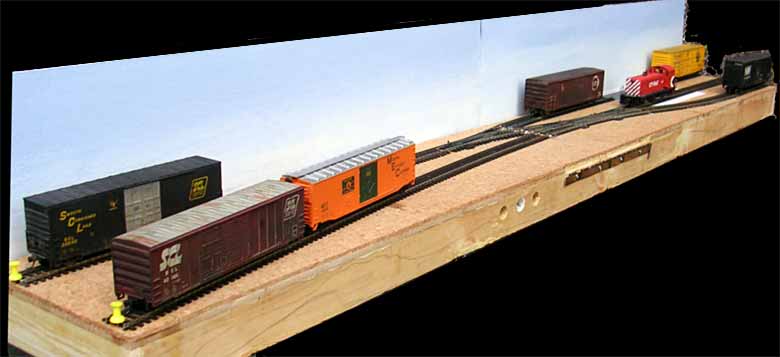
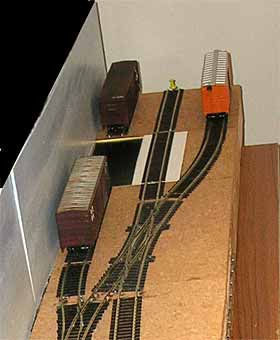 Yet another variation on Box Street comes from Jack Trollope, from his workshop in Ross-shire, Scottish Highlands. This time Jack is creating a variation on Alexander Lehmann’s Rainer’s Quay design, but in a larger area. The photos show under-construction progress on this layout, called Rayners Yard.
Yet another variation on Box Street comes from Jack Trollope, from his workshop in Ross-shire, Scottish Highlands. This time Jack is creating a variation on Alexander Lehmann’s Rainer’s Quay design, but in a larger area. The photos show under-construction progress on this layout, called Rayners Yard.
Instead of a sector plate as used in the original Box Street, Jack has substituted a small traverser (transfer table) that will eventually be concealed beneath a buildling. The traverser, as shown in the overview at left, can hold one locomotive thus producing a runaround capability that enables all the spurs to be reached and shunted. As usual, Jack uses American HO scale, mainly with 50ft modern cars.
SPREADING THE WORD ABOUT SMALL LAYOUTS
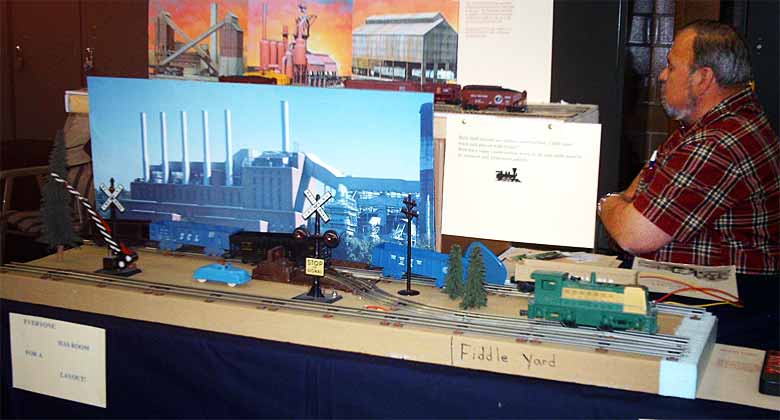
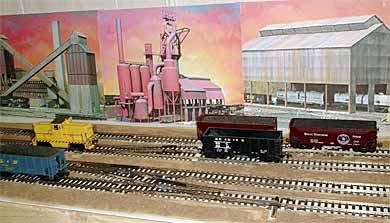 John Filius, from Roseau, Minnesota, USA, took not one but two 1x4ft (30x120cm) shelf layouts to his local train show recently. His theme was “Layouts for People Who Don’t Have Room for a Layout.” Both the featured layouts are still under construction, but they both operated at the show. Both represent portions of John’s fictitious Duquesne Witteburg Railway that serves steel mills and power plants by hauling coal and steel.The O-27 three-rail layout in the foreground depicts a siding serving a Duquesne Light & Power Co. power plant. Inexpensive Marx trains haul coal to the plant. The HO layout in the background (detail shown at right) is the Kennywood Yard, dedicated to coal operations to feed the mills. John also prepared and displayed a bulletin board showing pictures of a variety of small layouts from this site (he sought and received permission in advance). He reports, “We awakened some model railroaders, and the public in general, that you don’t need a room sized layout to have fun with our hobby.”
John Filius, from Roseau, Minnesota, USA, took not one but two 1x4ft (30x120cm) shelf layouts to his local train show recently. His theme was “Layouts for People Who Don’t Have Room for a Layout.” Both the featured layouts are still under construction, but they both operated at the show. Both represent portions of John’s fictitious Duquesne Witteburg Railway that serves steel mills and power plants by hauling coal and steel.The O-27 three-rail layout in the foreground depicts a siding serving a Duquesne Light & Power Co. power plant. Inexpensive Marx trains haul coal to the plant. The HO layout in the background (detail shown at right) is the Kennywood Yard, dedicated to coal operations to feed the mills. John also prepared and displayed a bulletin board showing pictures of a variety of small layouts from this site (he sought and received permission in advance). He reports, “We awakened some model railroaders, and the public in general, that you don’t need a room sized layout to have fun with our hobby.”
If you’ve undertaken some similar activities on behalf of small layouts, I’d love to hear from you and see photos!
WHO NEEDS TRACK SWITCHES?
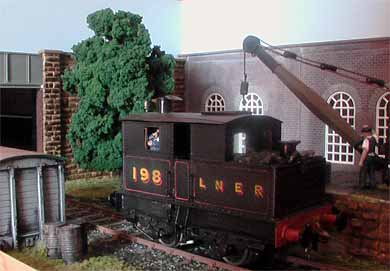
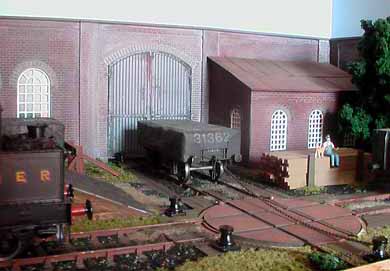
Englishman Colin French, a master of the minimum space O-scale layout, once said that “No O-scale layout should be longer than five feet!” His new layout, The Wagon Works (A Pointless Layout), illustrates his point beautifully–it measures 49x19in (124x48cm) in British O scale (1:43 – 7mm to the foot). The layout uses no track switches (“points” in England, thus the name). It features a small wagon turntable for moving cars into the repair works on the backdrop, which are based on Colin’s memories of the works in his hometown of Wolverton. The cars are moved using a rope or chain shunting arrangement with capstans (or are they bollards?).A small traverser hidden at the left handles a loco and one wagon. Locomotives depend on the location on display, which can be LMS, LNER or industrial, with various tank engines in use from the appropriate Company and associated with railway workshops over the years. The period depicted is the mid to late 1930’s. The unusual looking locomotive shown above is a classic Sentinel C.E. (“Centre Engine”) steam switcher that featured a vertical boiler and chain drive to the wheels. It was used primarily on the LNER.
Shown below are two photos of the layout dressed for the LMS, as it looked in its debut appearance at the Bressingham (Norfolk) Model Railway Day held in September 2006.
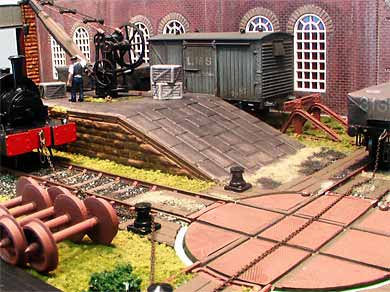
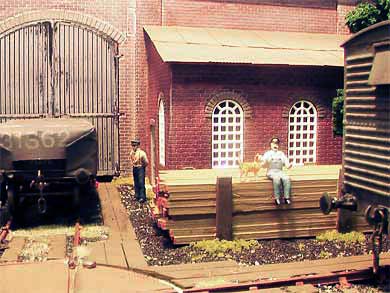
THIS TIMESAVER HAS TAKEN STEROIDS!
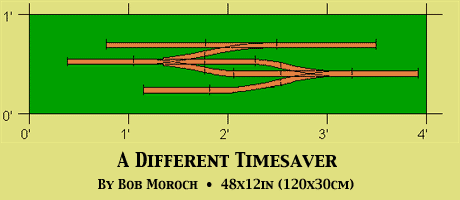


Meet the Green Valley District. Yes, the Timesaver is still in there somewhere, along with several Inglenooks. Bob has built and operates this monster. He describes an operating session this way: “There are six cars on the two lower left sidings. These represent cars spotted by an imaginary way freight. The other sidings contain 20 ‘locations’ where cars can be spotted. Fourteen are occupied. In an operating session, six cars are picked up and six cars from the yard are set out. It can take 45 minutes to complete.”
The photo at the top right was taken on the Green Valley District right of way. Would you believe that Bob is from Frisco, Texas, USA?
HERE’S A PASSENGER-TERMINAL MICRO LAYOUT!
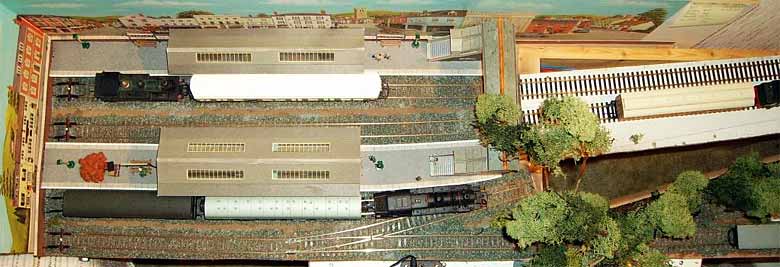
Nigel Beeton, from Bury St. Edmonds in Suffolk, England, adapted my design for Union Station into Evenley, a delightful 50x12in (127x30cm) passenger terminus with three platforms. In addition, he added a small shunting yard run with rules based on the Inglenook switching game. “I built it in a jiffy (I know, it shows!),” says Nigel, “but I’ve had great fun with it!”
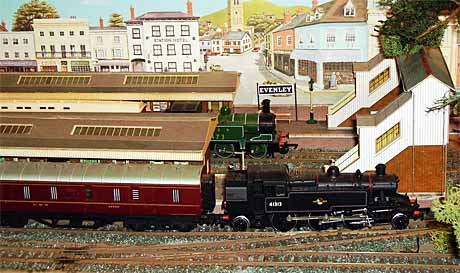
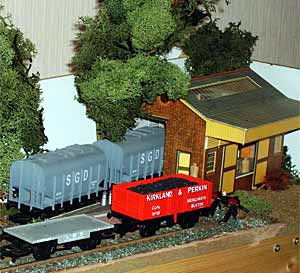
Leave a Reply